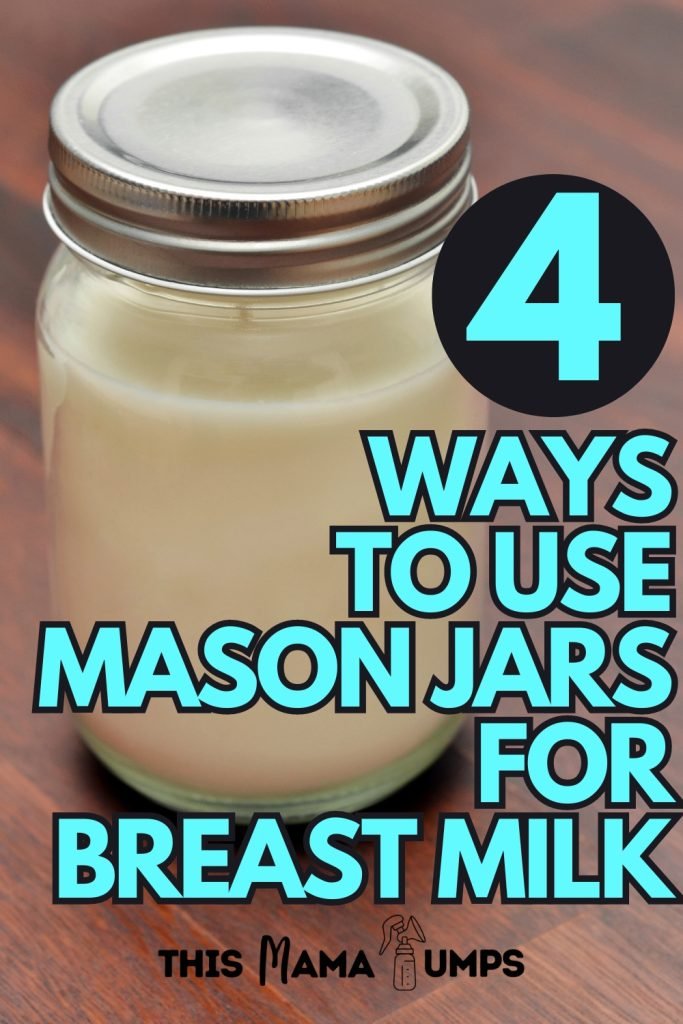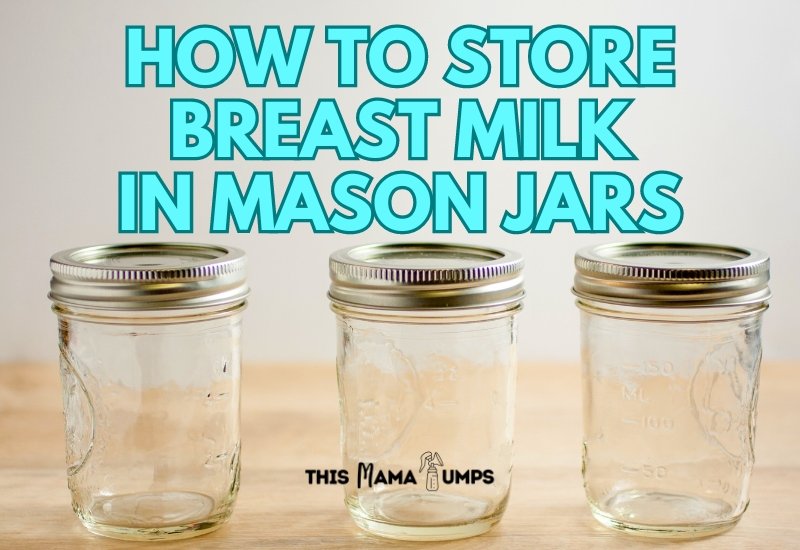Are you a breastfeeding mama looking for a practical way to store breast milk?
Maybe you’ve already got a handful of mason jars at home and wonder if you can use them for breast milk storage.
Or perhaps you’re looking for a way to use LESS plastic. And now you’re looking for alternatives like glass bottles.
Mason jars are a safe and eco-friendly option. Plus, you’ll save money in the long run!
This guide will teach you all the ins and outs of using these trusty jars to collect, store, and even feed your baby all in one jar.
But first, let’s answer the question..
Can you really store breast milk in mason jars?
Yes, definitely.
While they’re NOT technically marketed for babies, mason jars (or any glass jar) are great for storing breastmilk.
There’s even a company manufacturing mason bottles specifically for babies – offering nipples/teats and silicone sleeves.
Guess what the company’s name is? Mason Bottle!
You don’t have to get new mason bottles from them, though. You can use the ones you have at home or get any brand mason jars – just sterilize them first!
TIP: Replace the metal with plastic rings to prevent rusting.
What’s the deal with plastic, anyway?
Baby bottles have been BPA-free for years now. Bisphenol A (BPA) is a chemical used to harden plastic but it’s linked to many health issues. Back in 2012, the US FDA banned manufacturers from using BPA in baby bottles and sippy cups. [1]
BPA may have gotten out of fashion. But it has been replaced with other bisphenol analogues like BPS which is as hormone-disruptive. [2]
There’s increasing scientific evidence on the threat of synthetic chemicals and plastics to our health. Good thing, people are now more aware of the dangers. Even the American Academy of Pediatrics (AAP) recommends using plastic bottle alternatives like glass. [3]
Using plastic baby bottles also exposes your baby to microplastics. [4]
How To Use Mason Jars for Breastmilk

You can do it in 4 ways:
1. Pump directly into the mason jar
No pump brand currently exists that’s compatible with mason jars.
Sure, brands like Medela have a system where you can pump right into storage bags. But there’s no such system yet for mason jars.
That said, you can still pump into them — you just need an adapter!
First, you need to find one that’s suitable for your pump.
How to Pump into Mason Jars: Two Options
You’ve got two options. The first one has been out for a while. It was the ONLY option for many years. That is until the second one came out in the fall of 2023. And it’s got raving reviews already!
NanoBebe Breast Pump Adapter
This adapter is compatible with MOST breast pumps including Spectra, Medela, and Ameda. It’s sold per piece so you’ll need to buy 2 to double pump.
The downside? It can be tricky to use.
You’ll need to use the metal/plastic ring to keep it in place. See how it’s done in this video.
Nurse & Nourish Breast Pump and Mason Jar Adapter
This one’s fairly new to the market. It was just released in October 2023!
You don’t need to use the metal ring as this directly attaches to 4oz and 8oz mason jars. It’s compatible with wide-mouth pump parts (Spectra S1 and S2, Avent and Maymom).
2. Use the mason jar to store breast milk after pumping
For this, you use the bottle that comes with your pump.
Do this only if you’re OKAY with your baby’s milk coming into contact with plastic.
But if you want to minimize plastic use as much as possible, then pump directly into the glass jar.
Take note, your pump parts (flanges and connectors) are still made of plastic.
Freshly expressed milk can last up to 4 days in the fridge. But to be safe, freeze any extra milk within 24 hours.
3. Use the mason jar to freeze breast milk
You can pump straight into a mason jar, store it in the fridge, and freeze it at the end of the day. Or you can put it right into the freezer!
The best thing about this setup is you can use just ONE BOTTLE pumping all the way to freezing. And even thawing and feeding (more on this later).
If you want to use the glass jars solely for storage in the fridge or freezer, that’s fine too.
Just remember not to overfill and leave a bit of space for the liquid to expand when freezing. That way, it won’t explode.
4. Use the mason jar to feed your baby
Not only can you use these jars to store breast milk, but you can also feed your baby with it too!
Isn’t it amazing?
Mason Bottle offers wide breast-like nipples and silicone sleeves. Attach these to use the glass bottles for feeding.
The best part?
You can return the nipple in case your baby won’t take it. They’re the only bottle company with such a generous return policy!
Why should you store breast milk in Mason jars?
Aside from being non-toxic and eco-friendly, consider these
Pros:
- Less Washing – Pump, store, and feed from just one bottle!
- Less Waste – You waste precious drops of breastmilk by transferring from the pump bottle to the storage bag and finally to the feeding bottle.
- Preserve Nutrients – You lose fat-soluble vitamins when you use plastic BM storage bags versus glass since milk fat adheres to plastic. [5]
Cons:
- Bulky – takes up space in the fridge and freezer. You can’t store as much as you would with plastic storage bags.
- Heavy – can be heavy to hold when pumping or feeding. Use a smaller size (4oz. bottle), especially for younger babies.
When using a mason jar or any glass bottle, your baby might need help holding it. That’s something to be aware of.
With my baby, we used Dr. Brown’s glass bottles for feeding. For many months, we’ve been holding it for her. She only learned to hold the bottle on her own when she was nearly 12 months old!
Of course, she knew how to hold the bottle months before. But it was too heavy for her to hold for the entire feed.
As you probably know, propping up bottles using a towel or something similar is a no-go.
That goes for both plastic and glass baby bottles. It’s something that professionals WARN us about since it can cause harm. It can be fatal, too. [6]
But I understand if it’s something you HAVE to do at some point. No judgment from me! We all do what we have to do, given our circumstances.
Just be sure to keep an eye on the baby during feeding. Do not leave baby alone.
If you’re a twin mom, Caitlin has a great resource for tandem bottle feeding.
How to store breast milk in mason jars
- Choose a good brand. Not all mason jars are the same. Make sure to choose a reputable brand like Ball Mason Jars that are freezer-safe. There are reports of poorly made jars cracking and exploding.
- Sterilize. Pop into the bottle sterilizer or boil for 5 minutes.
- Pump or pour breastmilk into the jars and LABEL them. Put the date and time the milk was expressed. Make sure to leave at least 1oz. to allow room for expansion. (Liquids expand during freezing).
- Store in the fridge or freezer.
- Thaw frozen breastmilk by leaving it in the fridge overnight. Then soak in a bowl of hot water when you need to feed it. Some babies prefer cold milk. If that’s the case, you don’t need it to warm it.
What About You?
Have you tried using mason jars for collecting, storing, and feeding breastmilk?
Let me know how it goes. If you have any questions or suggestions, leave a comment below.
References:
- Mišľanová, C., Valachovičová, M., & Slezáková, Z. (2024). An Overview of the Possible Exposure of Infants to Microplastics. Life, 14(3), 371. https://doi.org/10.3390/life14030371
- Chen, D., Kannan, K., Tan, H., Zheng, Z., Feng, Y. L., Wu, Y., & Widelka, M. (2016). Bisphenol Analogues Other Than BPA: Environmental Occurrence, Human Exposure, and Toxicity-A Review. Environmental science & technology, 50(11), 5438–5453. https://doi.org/10.1021/acs.est.5b05387
- Trasande, L., Shaffer, R. M., Sathyanarayana, S., COUNCIL ON ENVIRONMENTAL HEALTH, Lowry, J. A., Ahdoot, S., Baum, C. R., FACMT, Bernstein, A.S., Bole, A., Campbell, C. C., Landrigan, P. J., Pacheco, S. E., Spanier, A. J., & Woolf, A. D. (2018). Food Additives and Child Health. Pediatrics, 142(2), e20181408. https://doi.org/10.1542/peds.2018-1408
- Li, D., Shi, Y., Yang, L., Xiao, L., Kehoe, D. K., Gun’ko, Y. K., Boland, J. J., & Wang, J. J. (2020). Microplastic release from the degradation of polypropylene feeding bottles during infant formula preparation. Nature food, 1(11), 746–754. https://doi.org/10.1038/s43016-020-00171-y
- McGuire, M., & O’Connor, D. L. (Eds.). (2021). Human milk: sampling and measurement of energy-yielding nutrients and other macromolecules. Academic Press. https://doi.org/10.1016/C2017-0-03495-X
- ‘Bottle propping’ warning after death of baby Alex Masters. (2018, February 10). BBC. https://www.bbc.com/news/uk-england-lincolnshire-43016506

